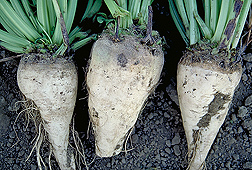This page has been archived and is being provided for reference purposes only. The page is no longer being updated, and therefore, links on the page may be invalid.
Read the magazine story to find out more. |
|
|
Scientists Turn Cheap Beet Pulp into Value-Added Plastics Ingredient
By Jan SuszkiwMarch 12, 2008
Sugar beet pulp may help cut the costs of making biodegradable plastic, Agricultural Research Service (ARS) studies suggest.
The pulp is a fiber-rich byproduct of sucrose extraction procedures used by sugar beet processors. Most of the 40 million tons of U.S. sugar beet pulp generated each year is used as an inexpensive livestock feed or pet-food ingredient. But ARS chemists Victoria Finkenstadt and LinShu Liu aim to breathe new economic life into the pulp.
Finkenstadt is with the ARS National Center for Agricultural Utilization Research (NCAUR) in Peoria, Ill. Liu is with the ARS Eastern Regional Research Center in Wyndmoor, Pa. Since 2004, they've collaborated on a project to convert sugar beet pulp into a specialized filler material for polylactic-acid-based plastics.
Polylactic acid (PLA) is considered a promising natural alternative to petroleum-based thermoplastics like polypropylene because PLA has comparable tensile strength and other mechanical properties, but is biodegradable. But PLA is costlier because of the complex processes required to derive it from fermented corn sugars, according to Finkenstandt, in NCAUR's Plant Polymer Research Unit.
Working with Liu's team at Wyndmoor, Finkenstadt and her Peoria colleagues showed that glycerol can be used to plasticize the pulp and reshape its particulate matter into tendrils. Early tests have been promising, but showed that the PLA's tensile strength decreased in relation to the amount of sugar beet pulp or plasticizer that was added. To get around the problem, Liu's group plans on chemically modifying the pulp so that its tendrils and the PLA matrix form a stronger bond.
Potential uses for pulp-based PLA composites range from nondurable goods such as water bottles, cups and packaging, to lightweight indoor-construction materials such as wallboard, tabletops and pressed furniture.
Read more about the research in the March 2008 issue of Agricultural Research magazine.
ARS is the U.S. Department of Agriculture's chief scientific research agency.

